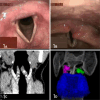Risk factors for the occurrence of arytenoid dislocation after major abdominal surgery: A retrospective study
- PMID: 39809151
- PMCID: PMC11596634
- DOI: 10.1097/MD.0000000000040593
Risk factors for the occurrence of arytenoid dislocation after major abdominal surgery: A retrospective study
Abstract
The incidence of arytenoid dislocation in abdominal surgery is relatively high, the cause is unknown, and it has not received sufficient attention. To identify the risk factors of arytenoid dislocation after abdominal surgery, and to establish a clinical prediction model based on relevant clinicopathological characteristics. We retrospectively collected the clinical data of 50 patients with arytenoid dislocation (AD) and 200 patients without AD after abdominal surgery with general anesthetic tracheal intubation in our Hospital from January 2013 to December 2019. General information about the patients was collected. Univariate analysis of the factors was performed, and indicators that were statistically significant were included in multivariate logistic regression analyses to identify the relationship between clinicopathological characteristics and arytenoid dislocation. Meanwhile, a clinical prediction model was established. Multivariate logistic regression analyses showed that age, surgical methods, operative time and gastric tube were dependent predictive factors of AD after abdominal surgery. A clinical prediction model was constructed, and the AUC of the ROC curve was 0.88 (95%CI: 0.83-0.94). The calibration plot shows that the prediction curve was close to the ideal curve. Patients undergoing abdominal surgery with general anesthesia exhibit a significantly higher incidence of AD due to a combination of factors. Clinicopathological features can be used as an independent predictor of risk in patients with AD, and a clinical model has been developed that is a good predictor of AD.
Copyright © 2024 the Author(s). Published by Wolters Kluwer Health, Inc.
Conflict of interest statement
The authors have no funding and conflicts of interest to disclose.
Figures





References
-
- Chinese Society of Anesthesiology. Expert consensus on the prevention and treatment of postoperative arytenoid dislocation. J Clin Anesthesiol. 2020;36:705–7.
-
- Xu W, Han D, Hu R, Bai Y, Zhang L. Characteristics of vocal fold immobility following endotracheal intubation. Ann Otol Rhinol Laryngol. 2012;121:689–94. - PubMed
-
- Wang S. Is There a causal relationship between endotracheal intubation and vocal cord paralysis? J Air Force Med Univ. 2022;43:389–94, F0003.
Publication types
MeSH terms
LinkOut - more resources
Full Text Sources
Medical

